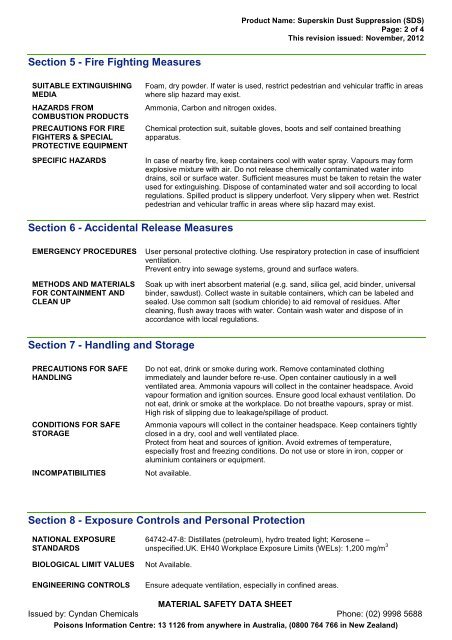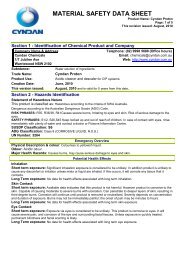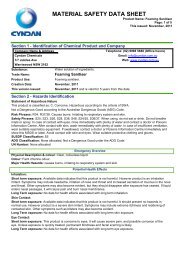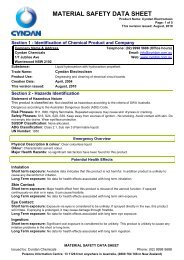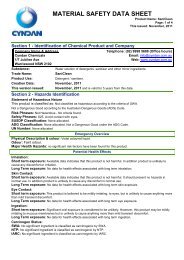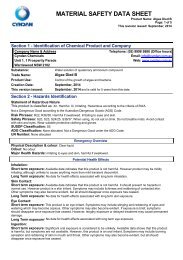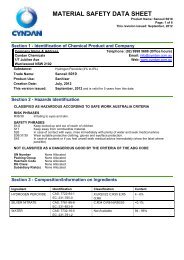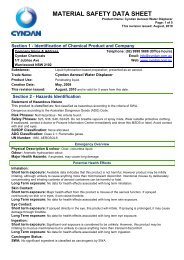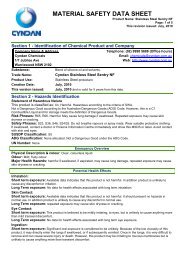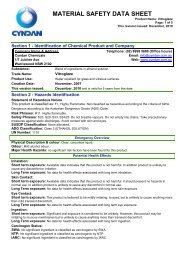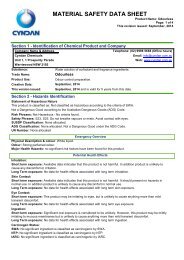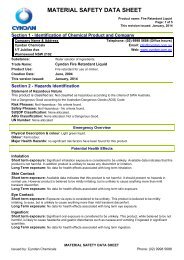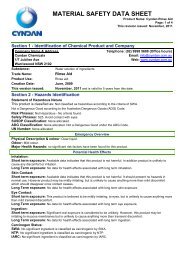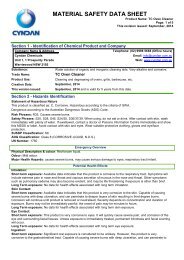Superskin Dust Suppression MSDS - CYNDAN Chemicals
Superskin Dust Suppression MSDS - CYNDAN Chemicals
Superskin Dust Suppression MSDS - CYNDAN Chemicals
Create successful ePaper yourself
Turn your PDF publications into a flip-book with our unique Google optimized e-Paper software.
Product Name: <strong>Superskin</strong> <strong>Dust</strong> <strong>Suppression</strong> (SDS)<br />
Page: 2 of 4<br />
This revision issued: November, 2012<br />
Section 5 - Fire Fighting Measures<br />
SUITABLE EXTINGUISHING<br />
MEDIA<br />
HAZARDS FROM<br />
COMBUSTION PRODUCTS<br />
PRECAUTIONS FOR FIRE<br />
FIGHTERS & SPECIAL<br />
PROTECTIVE EQUIPMENT<br />
SPECIFIC HAZARDS<br />
Foam, dry powder. If water is used, restrict pedestrian and vehicular traffic in areas<br />
where slip hazard may exist.<br />
Ammonia, Carbon and nitrogen oxides.<br />
Chemical protection suit, suitable gloves, boots and self contained breathing<br />
apparatus.<br />
In case of nearby fire, keep containers cool with water spray. Vapours may form<br />
explosive mixture with air. Do not release chemically contaminated water into<br />
drains, soil or surface water. Sufficient measures must be taken to retain the water<br />
used for extinguishing. Dispose of contaminated water and soil according to local<br />
regulations. Spilled product is slippery underfoot. Very slippery when wet. Restrict<br />
pedestrian and vehicular traffic in areas where slip hazard may exist.<br />
Section 6 - Accidental Release Measures<br />
EMERGENCY PROCEDURES<br />
METHODS AND MATERIALS<br />
FOR CONTAINMENT AND<br />
CLEAN UP<br />
User personal protective clothing. Use respiratory protection in case of insufficient<br />
ventilation.<br />
Prevent entry into sewage systems, ground and surface waters.<br />
Soak up with inert absorbent material (e.g. sand, silica gel, acid binder, universal<br />
binder, sawdust). Collect waste in suitable containers, which can be labeled and<br />
sealed. Use common salt (sodium chloride) to aid removal of residues. After<br />
cleaning, flush away traces with water. Contain wash water and dispose of in<br />
accordance with local regulations.<br />
Section 7 - Handling and Storage<br />
PRECAUTIONS FOR SAFE<br />
HANDLING<br />
CONDITIONS FOR SAFE<br />
STORAGE<br />
INCOMPATIBILITIES<br />
Do not eat, drink or smoke during work. Remove contaminated clothing<br />
immediately and launder before re-use. Open container cautiously in a well<br />
ventilated area. Ammonia vapours will collect in the container headspace. Avoid<br />
vapour formation and ignition sources. Ensure good local exhaust ventilation. Do<br />
not eat, drink or smoke at the workplace. Do not breathe vapours, spray or mist.<br />
High risk of slipping due to leakage/spillage of product.<br />
Ammonia vapours will collect in the container headspace. Keep containers tightly<br />
closed in a dry, cool and well ventilated place.<br />
Protect from heat and sources of ignition. Avoid extremes of temperature,<br />
especially frost and freezing conditions. Do not use or store in iron, copper or<br />
aluminium containers or equipment.<br />
Not available.<br />
Section 8 - Exposure Controls and Personal Protection<br />
NATIONAL EXPOSURE<br />
STANDARDS<br />
BIOLOGICAL LIMIT VALUES<br />
ENGINEERING CONTROLS<br />
64742-47-8: Distillates (petroleum), hydro treated light; Kerosene –<br />
unspecified.UK. EH40 Workplace Exposure Limits (WELs): 1,200 mg/m 3<br />
Not Available.<br />
Ensure adequate ventilation, especially in confined areas.<br />
MATERIAL SAFETY DATA SHEET<br />
Issued by: Cyndan <strong>Chemicals</strong> Phone: (02) 9998 5688<br />
Poisons Information Centre: 13 1126 from anywhere in Australia, (0800 764 766 in New Zealand)


